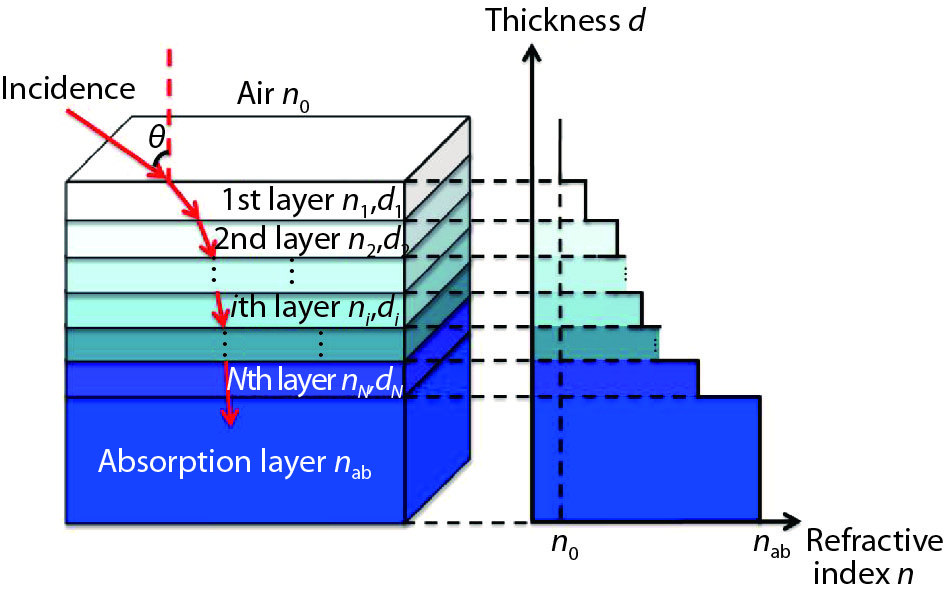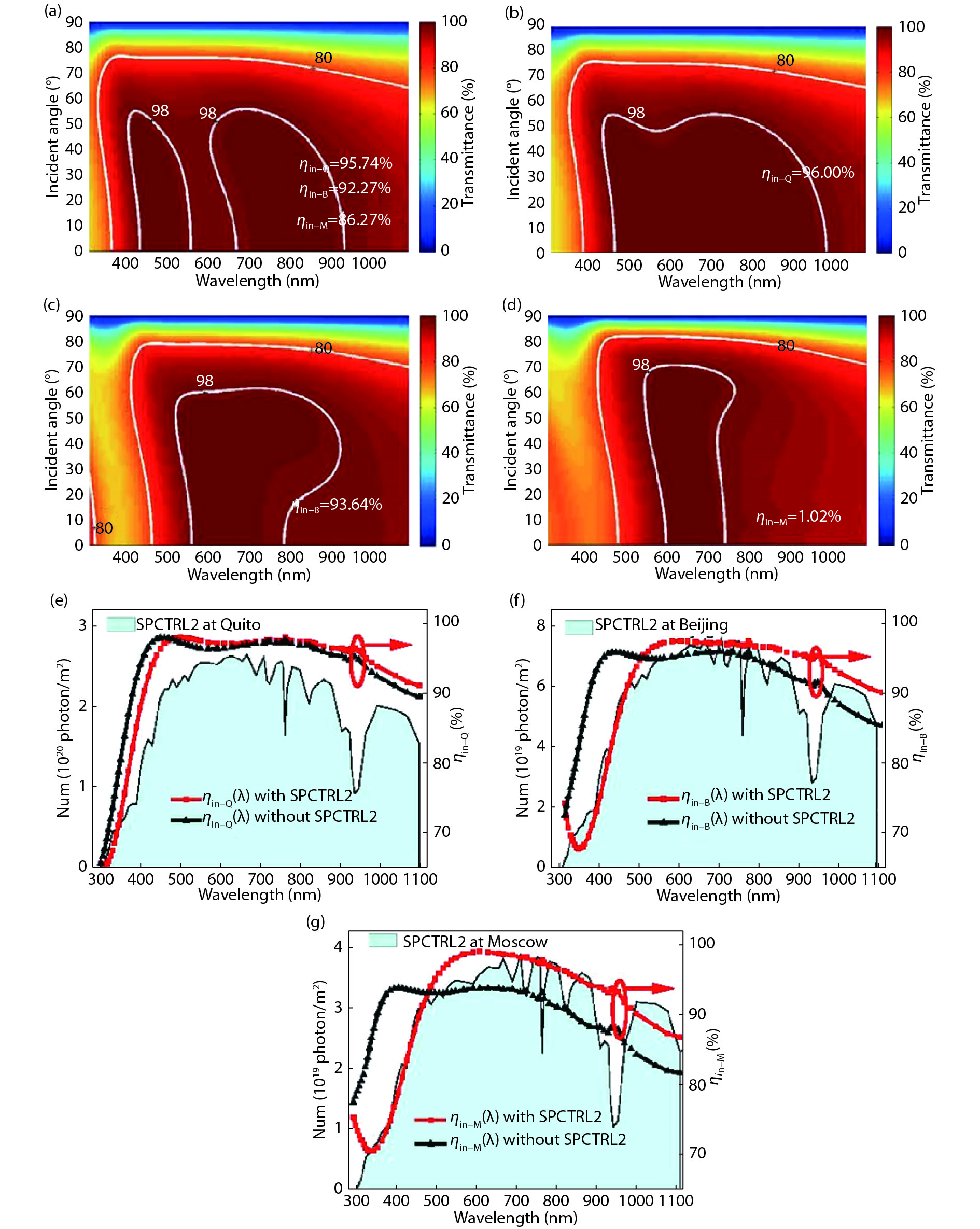| Citation: |
Xia Guo, Qiaoli Liu, Huijun Tian, Ben Li, Hongyi Zhou, Chong Li, Anqi Hu, Xiaoying He. Optimization of broadband omnidirectional antireflection coatings for solar cells[J]. Journal of Semiconductors, 2019, 40(3): 032702. doi: 10.1088/1674-4926/40/3/032702
****
X Guo, Q L Liu, H J Tian, B Li, H Y Zhou, C Li, A Q Hu, X Y He, Optimization of broadband omnidirectional antireflection coatings for solar cells[J]. J. Semicond., 2019, 40(3): 032702. doi: 10.1088/1674-4926/40/3/032702.
|
Optimization of broadband omnidirectional antireflection coatings for solar cells
DOI: 10.1088/1674-4926/40/3/032702
More Information
-
Abstract
Broadband and omnidirectional antireflection coating is generally an effective way to improve solar cell efficiency, because the destructive interference between the reflected and incident light can maximize the light transmission into the absorption layer. In this paper, we report the incident quantum efficiency ηin, not incident energy or power, as the evaluation function by the ant colony algorithm optimization method, which is a swarm-based optimization method. Also, SPCTRL2 is proposed to be incorporated for accurate optimization because the solar irradiance on a receiver plane is dependent on position, season, and time. Cities of Quito, Beijing and Moscow are selected for two- and three-layer antireflective coating optimization over λ = [300, 1100] nm and θ = [0°, 90°]. The ηin increases by 0.26%, 1.37% and 4.24% for the above 3 cities, respectively, compared with that calculated by other rigorous optimization algorithms methods, which is further verified by the effect of position and time dependent solar spectrum on the antireflective coating design. -
References
[1] Leem J W, Guan X Y, Choi M, et al. Broadband and omnidirectional highly-transparent coverglasses coated with biomimetic moth-eye nanopatterned polymer films for solar photovoltaic system applications. Sol Energ Mat Sol C, 2015, 134: 45. doi: 10.1016/j.solmat.2014.11.025[2] Rahman A, Ashraf A, Xin H, et al. Sub-50-nm self-assembled nanotextures for enhanced broadband antireflection in silicon solar cells. Nat Commun, 2015, 6: 5963. doi: 10.1038/ncomms6963[3] Tyagi V V, Rahim N A A, Rahim N A, et al. Progress in solar, PV technology: research and achievement. Renew Sust Energy Rev, 2013, 20: 443. doi: 10.1016/j.rser.2012.09.028[4] Louwen A, Sark W V, Schropp R, et al. A cost roadmap for silicon heterojunction solar cells. Sol Energ Mat Sol C, 2016, 147: 295. doi: 10.1016/j.solmat.2015.12.026[5] Rayleigh L. On reflection of vibrations at the confines of two media between which the transition is gradual. Proc London Math Soc, 1879, 1(1): 51.[6] Carlson D E, Wronski C R. Amorphous silicon solar cell. Appl Phys Lett, 1976, 28(11): 671. doi: 10.1063/1.88617[7] Zeng L, Yi Y, Hong C, et al. Efficiency enhancement in Si solar cells by textured photonic crystal back reflector. Appl Phys Lett, 2006, 89(11): 111111. doi: 10.1063/1.2349845[8] Xiong C, Xu W, Zhao Y, et al. New design graded refractive index antireflection coatings for silicon solar cells. Mod Phys Lett B, 2017, 31(19–21): 1740028. doi: 10.1142/S0217984917400280[9] Tao M, Zhou W, Yang H, et al. Surface texturing by solution deposition for omnidirectional antireflection. Appl Phys Lett, 2007, 91(8): 081118. doi: 10.1063/1.2775805[10] Bett A, Eisenlohr J, Höhn O, et al. Front side antireflection concepts for silicon solar cells with diffractive rear side structures. 29th European Photovoltaic Solar Energy Conference and Exhibition, 2014: 987.[11] Yang J, Luo F, Kao T S, et al. Design and fabrication of broadband ultralow reflectivity black Si surfaces by laser micro/nanoprocessing. Light Sci Appl, 2014, 3(7): e185. doi: 10.1038/lsa.2014.66[12] Huang Y F, Chattopadhyay S, Jen Y J. et al. Improved broadband and quasi-omnidirectional anti-reflection properties with biomimetic silicon nanostructures. Nat Nanotech, 2007, 2(12), 770. doi: 10.1038/nnano.2007.389[13] Diedenhofen S L, Vecchi G, Algra R E, et al. Broad-band and omnidirectional antireflection coatings based on semiconductor nanorods. Adv Mater, 2009, 21(9): 973. doi: 10.1002/adma.v21:9[14] Wang Z S, Kawauchi H, Kashima T, et al. Significant influence of TiO2 photoelectrode morphology on the energy conversion efficiency of N719 dye-sensitized solar cell. Coord Chem Rev, 2004, 248(13/14): 1381. doi: 10.1016/j.ccr.2004.03.006[15] Keis K, Magnusson E, Lindström H, et al. A 5% efficient photoelectrochemical solar cell based on nanostructured ZnO electrodes. Sol Energ Mat Sol C, 2002, 73(1): 51. doi: 10.1016/S0927-0248(01)00110-6[16] Cai J, Qi L. Recent advances in antireflective surfaces based on nanostructure arrays. Mater Horiz, 2015, 2(1): 37. doi: 10.1039/C4MH00140K[17] Xi J Q, Schubert M F, Kim J K, et al. Optical thin-film materials with low refractive index for broadband elimination of Fresnel reflection. Nat Photonics, 2007, 1(3): 176. doi: 10.1038/nphoton.2007.26[18] Guter W, Schöne J, Philipps S P, et al. Current-matched triple-junction solar cell reaching 41.1% conversion efficiency under concentrated sunlight. Appl Phys Lett, 2009, 94(22): 223504. doi: 10.1063/1.3148341[19] Liang Y, Feng D, Wu Y, et al. Highly efficient solar cell polymers developed via fine-tuning of structural and electronic properties. J Am Chem Soc, 2009, 131(22): 7792. doi: 10.1021/ja901545q[20] Hiramoto M, Fujiwara H, Yokoyama M. Three-layered organic solar cell with a photoactive interlayer of codeposited pigments. Appl Phys Lett, 1991, 58(10): 1062. doi: 10.1063/1.104423[21] Spinelli P, Verschuuren M, Polman A. Broadband omnidirectional antireflection coating based on subwavelength surface Mie resonators. Nat Commun, 2012, 3: 692. doi: 10.1038/ncomms1691[22] Campbell W M, Burrell A K, Officer D L, et al. Porphyrins as light harvesters in the dye-sensitised TiO2 solar cell. Coord Chem Rev, 2004, 248(13/14): 1363. doi: 10.1016/j.ccr.2004.01.007[23] Krebs F C, Tromholt T, Jørgensen M. Upscaling of polymer solar cell fabrication using full roll-to-roll processing. Nanoscale, 2010, 2(6): 873. doi: 10.1039/b9nr00430k[24] Liao H H, Chen L M, Xu Z, et al. Highly efficient inverted polymer solar cell by low temperature annealing of Cs2CO3 interlayer. Appl Phys Lett, 2008, 92(17): 156. doi: 10.1063/1.2918983[25] Barkhouse D A R, Gunawan O, Gokmen T, et al. Device characteristics of a 10.1% hydrazine-processed Cu2ZnSn(Se, S)4 solar cell. Prog Photovolt: Res Appl, 2012, 20(1): 6. doi: 10.1002/pip.v20.1[26] Blakers A W, Wang A, Milne A M, et al. 22.8% efficient silicon solar cell. Appl Phys Lett, 1989, 55(13): 1363. doi: 10.1063/1.101596[27] Poxson D J, M F Schubert M F, Mont F W, et al. Broadband omnidirectional antireflection coatings optimized by genetic algorithm. Opt Lett, 2009, 34(6): 728. doi: 10.1364/OL.34.000728[28] Oh S J, Chhajed S, Poxson D J, et al. Enhanced broadband and omni-directional performance of polycrystalline Si solar cells by using discrete multilayer antireflection coatings. Opt Express, 2013, 21(101): A157. doi: 10.1364/OE.21.00A157[29] Chang Y J. Suppressing lossy-film-induced angular mismatches between reflectance and transmittance extrema: optimum optical designs of interlayers and AR coating for maximum transmittance into active layers of CIGS solar cells. Opt Express, 2014, 22(101): A167. doi: 10.1364/OE.23.00A947[30] Chang Y J, Chen Y T. Broadband omnidirectional antireflection coatings for metal-backed solar cells optimized using simulated annealing algorithm incorporated with solar spectrum. Opt Express, 2011, 19(104): A875. doi: 10.1364/OE.19.00A875[31] Wang W. Design of nonpolarizing antireflection coating by using multiobjective optimization algorithm. Optik, 2013, 124(16): 2482. doi: 10.1016/j.ijleo.2012.08.022[32] Guo X, Zhou H Y, Guo S, et al. Design of broadband omnidirectional antireflection coatings using ant colony algorithm. Opt Express, 2014, 22(104): A1137. doi: 10.1364/oe.22.0a1137[33] Dorigo M, Gambardella L M. Ant colony system: a cooperative learning approach to the traveling salesman problem. IEEE Trans Evolut Comput, 1997, 1(1): 53. doi: 10.1109/4235.585892[34] Bird R E, Riordan C. Simple solar spectral model for direct and diffuse irradiance on horizontal and tilted planes at the earth's surface for cloudless atmospheres. SPIE, 1993, 54: 171 doi: 10.1175/1520-0450(1986)025<0087:SSSMFD>2.0.CO;2[35] Asadollahbaik A, Boden S A, Charlton M D, et al. Reflectance properties of silicon moth-eyes in response to variations in angle of incidence, polarisation and azimuth orientation. Opt Express, 2014, 22(102): A402. doi: 10.1364/oe.22.00a402[36] Boden S A, Bagnall D M. Sunrise to sunset optimization of thin film antireflective coatings for encapsulated, planar silicon solar cells. Prog Photovolt: Res Appl, 2009, 17(4): 241. doi: 10.1002/pip.v17:4[37] Holben B N, Eck T F, Slutsker I, et al. AERONET-A federated instrument network and data archive for aerosol characterization. Remote Sens Environ, 1998, 66(1): 1. doi: 10.1016/S0034-4257(98)00031-5 -
Proportional views






 DownLoad:
DownLoad:
















